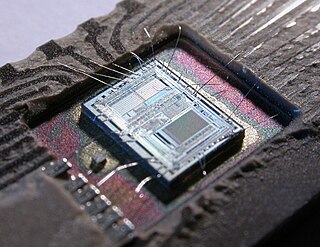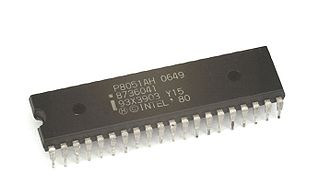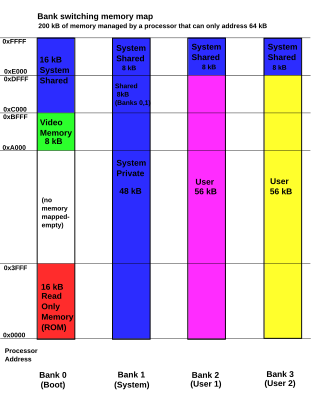
In computer programming, assembly language, often referred to simply as assembly and commonly abbreviated as ASM or asm, is any low-level programming language with a very strong correspondence between the instructions in the language and the architecture's machine code instructions. Assembly language usually has one statement per machine instruction (1:1), but constants, comments, assembler directives, symbolic labels of, e.g., memory locations, registers, and macros are generally also supported.
Forth is a procedural, concatenative, stack-oriented programming language and interactive integrated development environment designed by Charles H. "Chuck" Moore and first used by other programmers in 1970. Although not an acronym, the language's name in its early years was often spelled in all capital letters as FORTH. The FORTH-79 and FORTH-83 implementations, which were not written by Moore, became de facto standards, and an official technical standard of the language was published in 1994 as ANS Forth. A wide range of Forth derivatives existed before and after ANS Forth. The free and open-source software Gforth implementation is actively maintained, as are several commercially supported systems.

The Motorola 68000 is a 16/32-bit complex instruction set computer (CISC) microprocessor, introduced in 1979 by Motorola Semiconductor Products Sector.

A microcontroller or microcontroller unit (MCU) is a small computer on a single integrated circuit. A microcontroller contains one or more CPUs along with memory and programmable input/output peripherals. Program memory in the form of NOR flash, OTP ROM or ferroelectric RAM is also often included on chip, as well as a small amount of RAM. Microcontrollers are designed for embedded applications, in contrast to the microprocessors used in personal computers or other general purpose applications consisting of various discrete chips.

The Z80 is an 8-bit microprocessor introduced by Zilog as the startup company's first product. The Z80 was conceived by Federico Faggin in late 1974 and developed by him and his 11 employees starting in early 1975, before going on sale in July 1976. The processor is a software-compatible with the Intel 8080 but with several enhancements and at a lower price. Like the 8080, the Z80 was mainly aimed at embedded systems, but it became one of the most widely used CPUs in home computers of the late 1970s and early 1980s. The Zilog Z80 was also common in military applications, musical equipment, and coin-operated arcade games of the era, including Pac-Man.

The Intel MCS-51 is a single chip microcontroller (MCU) series developed by Intel in 1980 for use in embedded systems. The architect of the Intel MCS-51 instruction set was John H. Wharton. Intel's original versions were popular in the 1980s and early 1990s, and enhanced binary compatible derivatives remain popular today. It is a complex instruction set computer, but also has some of the features of RISC architectures, such as a large register set and register windows, and has separate memory spaces for program instructions and data.

Zilog, Inc. is an American manufacturer of microprocessors and 8-bit and 16-bit microcontrollers. It is also a supplier of application-specific embedded system-on-chip (SoC) products.

Bank switching is a technique used in computer design to increase the amount of usable memory beyond the amount directly addressable by the processor instructions. It can be used to configure a system differently at different times; for example, a ROM required to start a system from diskette could be switched out when no longer needed. In video game systems, bank switching allowed larger games to be developed for play on existing consoles.

The HD64180 is a Z80-based embedded microprocessor developed by Hitachi with an integrated memory management unit (MMU) and on-chip peripherals. It appeared in 1985. The Hitachi HD64180 "Super Z80" was later licensed to Zilog and sold by them as the Z64180 and with some enhancements as the Zilog Z180.
A barrel processor is a CPU that switches between threads of execution on every cycle. This CPU design technique is also known as "interleaved" or "fine-grained" temporal multithreading. Unlike simultaneous multithreading in modern superscalar architectures, it generally does not allow execution of multiple instructions in one cycle.

PSoC is a family of microcontroller integrated circuits by Cypress Semiconductor. These chips include a CPU core and mixed-signal arrays of configurable integrated analog and digital peripherals.
RS08 is a family of 8-bit microcontrollers by NXP Semiconductors. Originally released by Freescale in 2006, the RS08 architecture is a reduced-resource version of the Freescale MC68HCS08 central processing unit (CPU), a member of the 6800 microprocessor family. It has been implemented in several microcontroller devices for embedded systems.

The Rabbit 2000 is a high-performance 8-bit microcontroller designed by Rabbit Semiconductor for embedded system applications. Rabbit Semiconductor has been bought by Digi International, which is since selling the Rabbit microcontrollers and hardware based on them. The instruction set is based on the original Z80 microprocessor, but with some additions of new instructions as well as deletions of some instructions. Among the Z80 instructions missing in the Rabbit, cpir is particularly notable, since it allows for much more efficient implementations of some often-used standard C functions such as strlen, strnlen and memchr. According to the Rabbit documentation, it executes its instructions 5 times faster than the original Z80 microprocessor, that is, similarly to the Zilog eZ80.
TLCS is a prefix applied to microcontrollers made by Toshiba. The product line includes multiple families of CISC and RISC architectures. Individual components generally have a part number beginning with "TMP". E.g. the TMP8048AP is a member of the TLCS-48 family.
The Small Device C Compiler (SDCC) is a free-software, partially retargetable C compiler for 8-bit microcontrollers. It is distributed under the GNU General Public License. The package also contains an assembler, linker, simulator and debugger. As of March 2007, SDCC is the only open-source C compiler for Intel 8051-compatible microcontrollers. In 2011 the compiler was downloaded on average more than 200 times per day.
A modified Harvard architecture is a variation of the Harvard computer architecture that, unlike the pure Harvard architecture, allows memory that contains instructions to be accessed as data. Most modern computers that are documented as Harvard architecture are, in fact, modified Harvard architecture.
The 9S08 is an 8-bit microcontroller (µC) family originally produced by Motorola, later by Freescale Semiconductor, and currently by NXP, descended from the Motorola 6800 microprocessor. It is a CISC microcontroller. A slightly extended variant of the 68HC08, it shares upward compatibility with the aging 68HC05 microcontrollers, and is found in almost any type of embedded systems. The larger members offer up to 128 KiB of flash, and 8 KiB of RAM via a simple memory management unit (MMU) which allows bank-switching 16 KiB of the address space and an address/data register pair which allows data fetches from any address. The paging scheme used allows for a theoretical maximum of 4 MB of flash.
In computer programming, a constant is a value that is not altered by the program during normal execution. When associated with an identifier, a constant is said to be "named," although the terms "constant" and "named constant" are often used interchangeably. This is contrasted with a variable, which is an identifier with a value that can be changed during normal execution. To simplify, constants' values remains, while the values of variables varies, both hence their names. where as the constant variable of variation is the number that results two variables.
RL78 Family is a 16-bit CPU core for embedded microcontrollers of Renesas Electronics introduced in 2010.









